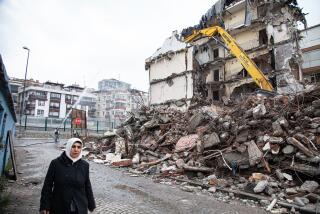Villagers Lament Ceausescu’s Razing of Homes : Romania: The dictator wanted to eliminate small settlements so people could be better controlled. His overthrow saved some homes.
CORNETU, Romania — Constantin Surescu, a 70-year-old farmer, stood in the wreckage of the house, fingering pieces of brick and the yellow balustrade that Nicolae Ceausescu’s police had ordered him to destroy.
What he could not destroy himself, a bulldozer finished off, all but a single room. But even then Surescu would not leave. For months, he, his wife and others huddled in the candle-lit room that had been spared, surviving the freezing winter with only a small charcoal stove.
Ceausescu had destroyed their lives and their village as part of his plan to move Romania’s rural population into big, concentrated towns.
When Ceausescu was overthrown Dec. 22, and executed with his wife three days later, Surescu’s family laughed and cried for joy.
But the nightmare for Surescu and dozens of neighbors in the village of Cornetu, 13 miles west of Bucharest, did not end.
“It would have been better if God had taken me,” Surescu said, clutching a color photograph of the large, well-kept beige house with relief designs he had moved into in 1961. “I don’t believe it will ever be the same.”
He continues to live in the room that remains.
He said he had developed heart disease because of the trauma.
The once leafy outskirts of Cornetu, with neat houses, well-tended gardens and grapevines climbing the walls, exist no more.
“Not even if we had a war would it look like this,” said a neighbor, Gheorghe Cristea, a 63-year-old bewhiskered farmer, shaking his head in disbelief.
Both sides of the muddy road heading west out of Cornetu are lined with the skeletons of a war Ceausescu tried to hide--one against the rural population. Many homes are just shells, some are missing roofs, others have holes in walls. Few escaped relatively unscathed.
Surescu and his 65 neighbors on the outskirts of town were luckier than the 350 families living in the center of Cornetu. Their homes were destroyed first.
Romania’s revolution saved the homes on the town’s edge from final destruction. The debris was to have been buried in huge pits already dug in gardens where flowers and vegetables once grew.
The center of Cornetu gives no hint that 350 houses once stood there. The houses were buried, and their grave is now covered with rows of four-story apartment buildings, Ceausescu’s response to the possibility of too much rural independence.
Some of the buildings destroyed were hovels, and the tenements are improvements, even though they are shoddily built structures that do not take into account rural life styles.
But the perception is widespread that Ceausescu had motives other than improving the quality of life for peasants.
Virgil Ioanid, vice president of the National Commission for Urban and Regional Planning, said Ceausescu apparently feared that he could not control small villages.
In the villages, local police were on good terms with the people, which angered Ceausescu, who felt he could not keep tabs on what was happening, Ioanid said.
With larger towns of 5,000 people or more, Ceausescu could bring in his fiercely loyal and hated Securitate secret police “and control was easier,” Ioanid added.
Ceausescu wanted to concentrate 10 million rural residents in 2,500 to 3,000 agro-industrial centers, said Serban Popescu-Criveanu, president of the commission.
Ceausescu intended to destroy 8,000 to 8,500 of Romania’s 11,000 rural villages, Popescu-Criveanu said.
“Fortunately, he didn’t have time to carry out his entire plan. . , but about 2,000 small houses were destroyed near Bucharest,” he said.
About 30 villages were affected, and eight were razed, he said.
Popescu-Criveanu added that one of the new government’s first commitments was to replace the destroyed homes as quickly as possible. He said that about 500 families did not want to return, but that the homes of the other 1,500 would be rebuilt.
Constantin Surescu recalled the day last May when the bulldozer, the police and town officials arrived.
“They ordered us to destroy our own houses,” he said.
“Many people said, ‘I don’t want to do this.’ If you said ‘No,’ they came in the night and got you and beat you up.”
First, electric power was disrupted, and that frightened some residents enough to start dismantling their homes with whatever implements they had at hand, Surescu said.
But others such as Surescu and his neighbor Cristea resisted, arguing with officials at town hall and scurrying into the fields when authorities came to their homes.
Cristea said they had heard on Western radio broadcasts that political change was sweeping Eastern Europe, and they expected something to happen in Romania, so they tried to delay the bulldozers as long as possible.
All residents whose homes were destroyed were given apartments in prefabricated concrete buildings. But in Cornetu’s outskirts, more than half the residents refused to leave their homes, begging the wreckers to leave one room intact.
“Even when they were destroying what I couldn’t destroy, I didn’t want to leave,” Surescu said.
“They gave me an apartment but I didn’t want to stay. . . . I felt like I was in a hospital. It was cold. There was water on the walls. It was like being in a grave.”
Now he was picking at the pieces of brick, gently fingering what was left of the home he had loved.
“I’m not leaving from here,” he said.
More to Read
Sign up for Essential California
The most important California stories and recommendations in your inbox every morning.
You may occasionally receive promotional content from the Los Angeles Times.










